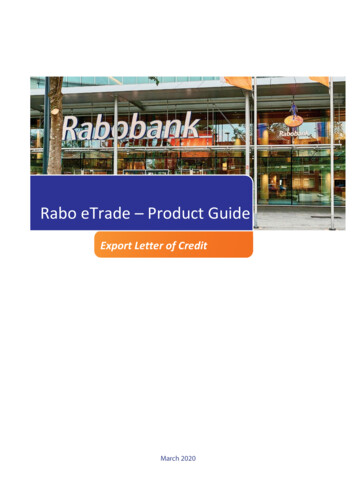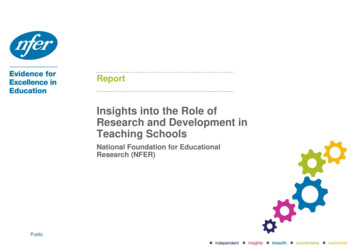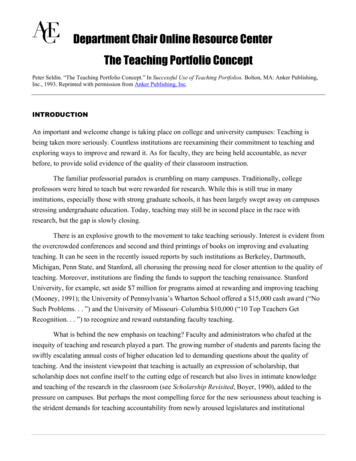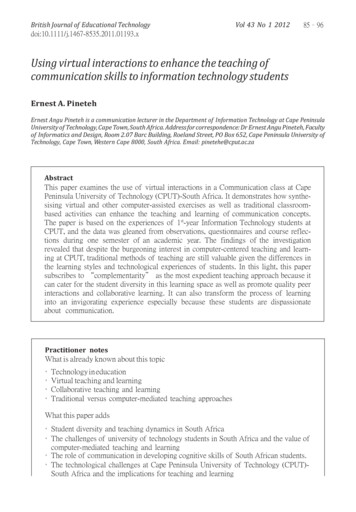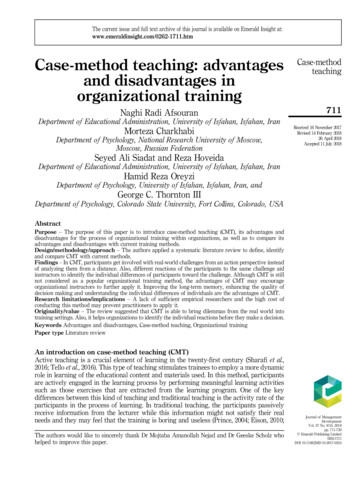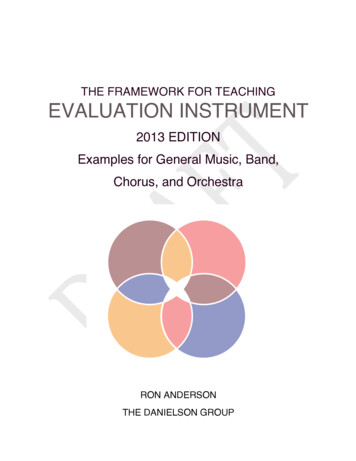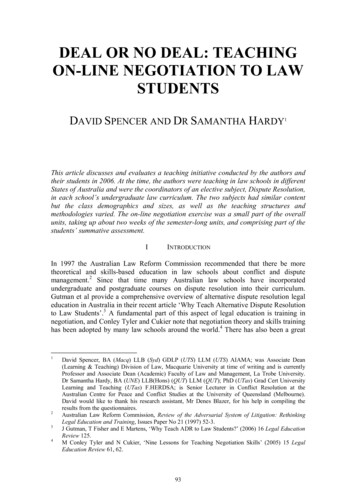
Transcription
DEAL OR NO DEAL: TEACHINGON-LINE NEGOTIATION TO LAWSTUDENTSDAVID SPENCER AND DR SAMANTHA HARDY1This article discusses and evaluates a teaching initiative conducted by the authors andtheir students in 2006. At the time, the authors were teaching in law schools in differentStates of Australia and were the coordinators of an elective subject, Dispute Resolution,in each school’s undergraduate law curriculum. The two subjects had similar contentbut the class demographics and sizes, as well as the teaching structures andmethodologies varied. The on-line negotiation exercise was a small part of the overallunits, taking up about two weeks of the semester-long units, and comprising part of thestudents’ summative assessment.IINTRODUCTIONIn 1997 the Australian Law Reform Commission recommended that there be moretheoretical and skills-based education in law schools about conflict and disputemanagement.2 Since that time many Australian law schools have incorporatedundergraduate and postgraduate courses on dispute resolution into their curriculum.Gutman et al provide a comprehensive overview of alternative dispute resolution legaleducation in Australia in their recent article ‘Why Teach Alternative Dispute Resolutionto Law Students’.3 A fundamental part of this aspect of legal education is training innegotiation, and Conley Tyler and Cukier note that negotiation theory and skills traininghas been adopted by many law schools around the world.4 There has also been a great1234David Spencer, BA (Macq) LLB (Syd) GDLP (UTS) LLM (UTS) AIAMA; was Associate Dean(Learning & Teaching) Division of Law, Macquarie University at time of writing and is currentlyProfessor and Associate Dean (Academic) Faculty of Law and Management, La Trobe University.Dr Samantha Hardy, BA (UNE) LLB(Hons) (QUT) LLM (QUT); PhD (UTas) Grad Cert UniversityLearning and Teaching (UTas) F.HERDSA; is Senior Lecturer in Conflict Resolution at theAustralian Centre for Peace and Conflict Studies at the University of Queensland (Melbourne).David would like to thank his research assistant, Mr Denes Blazer, for his help in compiling theresults from the questionnaires.Australian Law Reform Commission, Review of the Adversarial System of Litigation: RethinkingLegal Education and Training, Issues Paper No 21 (1997) 52-3.J Gutman, T Fisher and E Martens, ‘Why Teach ADR to Law Students?’ (2006) 16 Legal EducationReview 125.M Conley Tyler and N Cukier, ‘Nine Lessons for Teaching Negotiation Skills’ (2005) 15 LegalEducation Review 61, 62.93
SPENCER & HARDY(2008)deal of research about appropriate methodologies for teaching negotiation, and aselection of these is discussed in the next section of the paper.In their recent article ‘Nine Lessons for Teaching Negotiation’, Conley Tyler andCukier note that ‘with lawyers around the world now using on-line communication suchas email to conduct negotiations, an understanding of the differences in communicationand negotiation techniques involved is vital’.5 They call for further studies in relation tothese nine lessons, and specifically those utilising the ever-changing phenomenon of online technology and note that this research is important in order to further refineteaching methods and produce optimal learning outcomes.6 This paper answers that calland makes some important suggestions for the use of on-line negotiation simulations innegotiation training and in practice.IITEACHING NEGOTIATION IN A BACHELOR OF LAWS PROGRAMThere are many reasons to teach negotiation in an undergraduate law program. BrucePatton, Deputy Director of the Harvard Negotiation Project, argues that negotiationtraining in law schools changes students’ behaviour and attitudes by increasingstudents’ confidence, competence, and satisfaction in dealing with a broad range ofnegotiation contexts and roles, and also by helping students learn how to keep learningfrom future experience.7 Williams and Geis also suggest that negotiation training offersan opportunity for both students and teachers to ‘gain greater self-understanding as wellas a greater appreciation for others’.8 However, how well these aims are achieveddepends greatly on the design of the negotiation training.There are a number of perceived and actual challenges in effectively teachingnegotiation. Bruce Patton refers to some perceived obstacles, including that negotiationcannot be taught, that skills courses are inappropriate for a scholarly institution, and thatnegotiation theory is imperfect.9 Other more recognised barriers include the fact thatstudents are required to change habits long developed and deeply ingrained,10 and whatMichael Wheeler calls ‘the ethics challenge’ and ‘the power challenge’.11 The ethicschallenge refers to the difficult goal of teaching students how to negotiate and how torelate to one another more effectively. The power challenge is the problem of howpeople deal with issues of social identity and equity, and how these affect interactionsthat are shaped by roles and status. Despite these difficulties, there is a ‘healthy variety’in the ways negotiation is taught in law schools12 and this teaching appears to be largelysuccessful.56789101112Ibid 85.Ibid 84.Bruce M Patton, ‘On Teaching Negotiation’ in Michael Wheeler (ed), Teaching Negotiation: Ideasand Innovations (2000) 7.Gerald R Williams and Joseph M Geis, ‘Negotiation Skills Training in the Law School Curriculum’in Michael Wheeler (ed), Teaching Negotiation: Ideas and Innovations (2000) 203, 211.Patton, above n 7, 7-16.Ibid 7.M Wheeler, ‘Is Teaching Negotiation Too Easy, Too Hard, or Both?’ (2006) Negotiation Journal187, 189.Williams and Geis, above n 8, 206.94
Vol 8 No 1 (QUTLJJ)Deal or no Deal: Teaching On-line Negotiation toLaw StudentsMost negotiation training shares a set of similar objectives. Conley Tyler and Cukierreviewed a large number of negotiation programs and identified the following commongoals: to impart some type of theoretical framework for understanding negotiation; toprovide opportunities to practice negotiation; to reflect on students’ experiences ofnegotiation; and to encourage students to continue their learning process.13 There isinsufficient room in this paper to review the wide range of approaches to achievingthese goals. However, one tool that is commonly used and that forms the basis of theteaching initiative on which this paper is focused, is simulated role play. Conley Tylerand Cukier point out that students will not learn just from theory, and negotiationsimulations provide an opportunity to put theory into practice and try out new skills.Simulations and role-plays provide an opportunity for experiential learning, or‘learning-by-doing’ and are particularly useful in challenging existing habits andallowing students to try out and integrate new ideas, concepts, and principles in a lowrisk environment.14 However, Wheeler warns that merely providing students withopportunities to experiment via role-play simulations is, by itself, unlikely to be trulytransformative.15 In order for role-plays to be effective, it is important that they arecredible, relevant, and contextual, and that they are followed by a rich reflective reviewand analysis of students’ negotiation experience.16 This kind of review may take theform of individual or group debriefing sessions, peer feedback and discussion, orwritten reflective journals.In recent years, information and communication technologies have been increasinglyused in negotiation training. Köszegi and Kersten argue that the use of e-learningtechnology is appropriate for both the training of conventional negotiation skills as wellas new technology-related skills.17 Given the frequent use of technology in conductingnegotiations, understanding this medium is important to prepare students for practice. Inaddition, the use of technology in negotiation training can enhance the learningprocess.18 Previous studies have shown that the use of technology in negotiationtraining: 13141516171819assists students with reflective analysis, as their interactions can be recorded,retrieved and sorted with ease; andallows for a delay in between communication (in contrast with the immediacy offace-to-face negotiation), which provides students with the time to think andformulate their responses before communicating them to the other party.19Conley Tyler and Cukier, above n 4, 64.L E Susskind and J Corburn, ‘Using Simulations to Teach Negotiation: Pedagogical Theory andPractice’ in Michael Wheeler (ed), Teaching Negotiation: Ideas and Innovations (2000) 285; SabineKöszegi and Gregory E Kersten, On-line/Off-line: Joint Negotiation Teaching in Montreal andVienna (2003) InterNeg 2 http://interneg.org/ at 22 April 2008.Wheeler, above n 11, 189.Conley Tyler and Cukier, above n 4, 71; Patton, above n 7, 19-22; Susskind and Corburn, above n14, 302-6; Köszegi and Kersten, above n 14, 2.Köszegi and Kersten, above n 14, 2.Conley Tyler and Cukier, above n 4, 64.Ibid 83; A P Lempereur, ‘Innovation in Teaching Negotiation: Towards a Relevant Use ofMultimedia Tools’ (2004) 9 International Negotiation 141, 143; Köszegi and Kersten, above n 14, 910; Derry Dance, ‘Lessons Learned in On-line Education: On-line Business Negotiation’ (Paperpresented at the Teaching On-line in Higher Education Conference, held entirely on-line, 10-1295
SPENCER & HARDY(2008)There are a range of approaches to teaching negotiation with multimedia tools. Forexample: negotiation roleplays may be carried out using email, live chat, or videoconferencing; negotiation exercises may be based on direct communication betweenstudents, or using a computer simulation package; students may negotiate as individualsor in groups, with students in their own class with whom they are familiar, or withstudents from other universities in the same or other countries; and technology mayform the basis for all learning and teaching in the course, or just one of the tools used ina face-to-face course.20 Saunders and Lewicki point out that a primary question for theteacher of negotiation considering the use of technology is: What is the purpose of usingit?21 Purposes might include acquiring new knowledge, reinforcing and practising theacquisition of knowledge previously acquired, and evaluating and testing the acquisitionof that knowledge.22Alain Lempereur reports on simulated cross-cultural e-mail negotiations betweenFrench, American, Japanese and Canadian students.23 The structure of the exercise wasquite similar to the one the subject of this paper, although ours did not have the addedcomplexity of cultural and language barriers. Students in both exercises negotiated byemail, participated in a debriefing session, and answered questionnaires after theexperience. Lempereur reports the following key lessons, which are reflected in our ownfindings: 2021222324Technical difficulties can sometimes make negotiation exchanges a nightmare,obliging students to wait until they can obtain the correct e-mail address or anefficient Internet connection.Students often waited longer than they expected before receiving an answer fromtheir counterpart.Students grew accustomed to the fact that some students were not as skilled in theuse of e-mail and needed to accept that time differences could pose an obstacle forexchanges, though it also allowed more time for reflection between messages.Students were able to read and reread messages and take the time to decide how toanswer in the most appropriate way.Many students also found that the use of e-mail as a medium altered theirnegotiation style, though during the discussions it was not clear how. It may be thecase that students who tended to be more relational may not have interacted as muchas they would have otherwise.A majority of students thought that e-mail tended to keep the relationship at asuperficial level.This type of negotiation did not appear easier or more difficult than face-to-faceinteractions and did not clearly make students tenser or more uncomfortable.24November2004),paperavailableat: http://www.ipfw.edu/tohe/Papers/Nov%2012/0216 odr paper final.pdf at 9 January 2008; D MSaunders and R J Lewicki, ‘Teaching Negotiation with Computer Simulations: Pedagogical andPractical Considerations’ (1995) 11 Negotiation Journal 157, 166.See, for example, Lempereur, above n 19; Köszegi and Kersten, above n 14; Dance, above n 19;Saunders and Lewicki, above n 19, 157.Saunders and Lewicki, above n 19, 157.Ibid.Lempereur, above n 19.Ibid 143.96
Vol 8 No 1 (QUTLJJ)Deal or no Deal: Teaching On-line Negotiation toLaw StudentsLempereur also noted that students involved in the exercise had to be more selfdependent and more patient, and that some became stressed when the other party did notanswer, or was not ‘professional’ enough. Students in the different locations alsodemonstrated partisan perceptions, and often referred to ‘our group’ and ‘their group’.25This was also evidenced in our exercise, even though the two groups were lessculturally differentiated.Other similar studies have found that e-negotiation: Allows more time for preparation, the assessment of offers and counter-offers, andthe possibility of integrating time pressures in tactics;26Lessens social pressures, by giving students the ability to remain anonymous, andthus the opportunity to experiment with different approaches, or to conceal theirgender or ethnicity;27 andMade it difficult for students to establish rapport, a good relationship and build trust,as it can be difficult to interpret others’ behaviour.28These findings were also reflected in the comments made by the students whoparticipated in our exercise.IIITHE MACQUARIE UNIVERSITY AND UNIVERSITY OF TASMANIA ON-LINENEGOTIATIONThe Macquarie University is located in Sydney, New South Wales and the University ofTasmania is located in Hobart, Tasmania. The two universities’ dispute resolutionsubjects had similar content but the class demographics and sizes, as well as theteaching structures and methodologies varied. Macquarie University’s Division of Lawteaches ‘LAW415 Dispute Management & Resolution’ every year in second semester asan elective unit in their Bachelor of Laws program. In 2006 the unit attracted 182students of whom 131 were full time students and 51 were part-time students. Twoteachers delivered the unit – one as unit convener/lecturer/tutor and the other as a tutor.The Faculty of Law at the University of Tasmania teaches ‘LAW622 DisputeResolution Law & Practice’ every second year as an elective unit in their Bachelor ofLaws program. Unit enrolments are capped each year to maximise the amount offeedback students receive on the practical components of the unit. In 2006 the unit wascapped at 32 students. The unit was delivered in total by the unit convener only, withoutany other teaching staff. Ethics approval was obtained from both universities. Thequestionnaire returns showed an overall return rate of 53.5% with Macquarie studentsaccounting for a 51% return rate, and the University of Tasmania students accountingfor a 56% return rate. The on-line negotiation exercise was a small part of the overallcourses, taking up about two weeks of the semester-long courses, and comprising 20%30% of the students’ summative assessment (this varied across the differentuniversities). The learning and teaching aims of the exercise were:25262728Ibid 146.Köszegi and Kersten, above n 14, 7.Ibid 8.Ibid; Dance, above n 19, 4-6.97
SPENCER & HARDY(a)(b)(c)(d)(2008)For students to engage in a simulated on-line negotiation;For students to apply the theory and philosophy of negotiation to the simulation ina practical sense, in particular, the principled model of negotiation;For students to develop interpersonal and communication skills through thesimulation; andFor students to reflect on the positives and negatives of the on-line setting inconducting a negotiation.The anticipated learning and teaching outcomes were:(a)(b)(c)(d)Participation in a simulated on-line negotiation;Understanding of the difficulties and advantages of the on-line setting inconducting a negotiation;Application of the theoretical models of negotiation, in particular, principlednegotiation in a simulated negotiation exercise; andReflection on the conduct of a simulated on-line negotiation, with particularemphasis on the on-line setting and the theoretical and philosophical principles ofnegotiation.Each student from the University of Tasmania was paired with a student fromMacquarie University. Students were given their opposing student email address(determined by the unit convenors), the Rules of Engagement, the fact scenario and aNegotiation Debrief Questionnaire. Students from each university all acted for the sameside of the dispute, which set up an element of rivalry. Students were instructed thatthey did not have to settle the dispute, and were encouraged to employ a principledmodel of negotiation (although they were permitted to use other models if they thoughtit appropriate). Students were encouraged to consider options outside of monetarycompensation to resolve the dispute. In other words, students were encouraged to usecreative option generation as a way to resolve the dispute.The fact scenario was a simple commercial dispute involving a company supplying coalto another company to drive smelting machinery for the production of steel. The coalwas found to be contaminated and caused the buyers of the coal to suffer damages as aresult of having to clean out its furnaces and to replace the dirty coal. There werespecific figures in relation to damages supplied in the fact scenario, as well as aprevious and on-going relationship (and love of golf) between the two company chiefexecutive officers.The negotiation opened at a prescribed date and time, and closed at a prescribed dateand time. Students were instructed that all correspondence in the negotiation was to beconducted directly between the students via the email addresses. Communications wereto be recorded in the form of a negotiation log. At the conclusion of the negotiationstudents filled out the questionnaire and submitted it electronically to their respectiveunit convenor. Students also wrote up a reflective journal of no more than 2000 wordswith the negotiation log annexed to the journal.The reflective journal consisted of between 20%-30% of the final total mark for theunits (this varied across the different universities). Assessment was based on thesubmission of a reflective journal containing two components. The first component ofthe reflective journal was the reflective commentary of the negotiation. Students were98
Vol 8 No 1 (QUTLJJ)Deal or no Deal: Teaching On-line Negotiation toLaw Studentsadvised that this was not to be a transcript of what happened between the students. Itwas to be a thoughtful reflection on what happened during the negotiation that will seekto address:(a)(b)(c)(d)(e)(f)How the theories and philosophies of negotiation translated into the practice ofnegotiationWhy certain negotiation strategies were adopted or discardedWhat difficulties the on-line setting presented to the conduct of the negotiationWhat advantages the on-line setting presented to the conduct of the negotiationWhat could have been done better to make the negotiation more effectiveIf the student could change anything, what would the student change to make thenegotiation more effective?The second component consisted of the negotiation log which was a cut-and-pasterecord of the on-line negotiation that was a reference point for the reflections made bystudents.THE RESULTSIVAQuantitative ResultsAppendix 1 sets out the statistical data of the returned questionnaires. Table 1 shows thecombined results of both universities by question and the number of responses to eachproposition. Question 1 asked students to respond by way of five preferences, rangingfrom strongly disagreeing to strongly agreeing, to the proposition that the on-linenegotiation exercise was a useful activity for learning about negotiation. As table 1shows, 98% of responding students strongly agreed or agreed that the exercise wasworthwhile in learning about negotiation. Question 2 saw combined responses in theorder of 96% of students strongly agreeing or agreeing that the exercise was a usefulactivity for learning about on-line negotiation. These results support Susskind andCorburn’s hypothesis that negotiation training via the use of role play allows students totest the theory they have learned in a low risk environment and that experience in itselfleads to effective learning in the theory and skills of negotiation.2929Susskind and Corburn, above n 14, 285-310.99
SPENCER & HARDY(2008)706050Number ofResponses403020100Q1Q2Strongly DisagreeQ3DisagreeQ4NeutralAgreeQ5Q6Strongly AgreeTable 1: Overall Quantitative ResponsesWhile an overwhelming majority of students saw the exercise, as a learning experienceof the skills of negotiation, as being effective, that same group of students saw far lessvalue in on-line negotiation as a way to effectively resolve disputes and buildrelationships. Question 3 asked students to respond to the proposition that on-linenegotiation is an effective method of resolving disputes and saw combined responsesonly in the order of 49.5% strongly agreeing or agreeing with the proposition. Neutralresponses accounted for 32.5% of responses, with a further 17% disagreeing with theproposition. Question 4 asked students to respond to the proposition that on-linenegotiation is an effective method of building relationships and similarly saw reducedagreement with the proposition down to 28.5% for those that strongly agreed or agreedwith the proposition. Neutral responses accounted for 27% of responses, with a further33.5% disagreeing with the proposition, and 11% strongly disagreeing with theproposition.This lack of confidence that on-line negotiation can address relationships issues andlead to a resolution of the dispute is in stark contrast to the confidence studentsdisplayed about the learning benefits of the exercise. Perhaps the positive learninggained from this exercise was the notion that on-line negotiation does pose problems inrelation to the chances of successful resolution and the possibility of building healthyrelationships as a result of the dispute. If this hypothesis is correct, then the learningexperience derived by the students has been a valuable one from the perspective ofhighlighting the problems that on-line negotiation presents to its participants. This resultis consistent with the findings of academic commentators in the field who warn that thelack of human contact through on-line dispute resolution processes jeopardises thechance of resolution, predominantly through the missed opportunity to buildrelationships that occurs through a reduction of emotional content present in on-linemediums.30 These issues will be further discussed below when we deal with thequalitative results.30See, for example, T Schultz, G Kaufman-Kohler, D Langer and V Bonnett, On-line DisputeResolution: The State of the Art and the Issues (2001) On-line Dispute Resolution [7] http://www.on-line-adr.org at 23 April 2008; S Hardy, ‘On-line Mediation: Internet DisputeResolution’ (1998) 9 Australian Dispute Resolution Journal 216, 218-19.100
Vol 8 No 1 (QUTLJJ)Deal or no Deal: Teaching On-line Negotiation toLaw StudentsQuestion 5 asked for responses to the proposition that on-line negotiation promoteseffective negotiation. Table 1 shows that only 44% of students strongly agreed or agreedwith that proposition, while 36% were neutral to the proposition, with a further 20%disagreeing or strongly disagreeing with the proposition. The qualitative results to bediscussed below may explain these responses, however, for the moment it would seemthat the contrived nature of the exercise, in terms of its timeframe and lack of ability tocontrol the parameters of the negotiation, played a significant role in the poorly-heldview that on-line negotiation can promote effective negotiation.The final qualitative question sought responses to the proposition that students wouldrecommend the on-line negotiation assessed task for inclusion in the unit next time theunit is run at the respective law schools. Of the students responding, 87% stronglyagreed or agreed that the activity should be run again, with only 8% neutral to the ideaand 5% disagreeing or strongly disagreeing. From a teaching perspective these are quitegood results that indicate that the assessed activity was received very well by studentsand that it enhanced their learning experiences within the unit.605040Number ofResponses3020100Q1Q2Strongly DisagreeQ3DisagreeQ4NeutralAgreeQ5Q6Strongly AgreeTable 2: Macquarie Quantitative Responses12108Number ofResponses6420Q1Q2Strongly DisagreeQ3DisagreeQ4NeutralTable 3: University of Tasmania Quantitative Responses101AgreeQ5Strongly AgreeQ6
SPENCER & HARDY(2008)Tables 2 and 3 graph the individual institutional results and do not indicate any trendworthy departure from the combined results. Tasmanian results were a little flatter at thepositive end of the spectrum for the value of the exercise in learning about negotiationand in particular on-line negotiation but not enough to warrant any further analysis atthis stage.BQualitative ResultsThere were six questions asked of students that allowed for a qualitative response. Inorder to analyse the answers provided by students the responses have been broken upinto the questions and the themes that flowed from the answers.1Question 1(a) – ‘Why was principled negotiation used’ - Theme 1 – ‘An effectivemodel’The first question asked, ‘Did you employ the principled negotiation model ofnegotiation? If so, why? If not, why?’ Out of the 111 respondents to the questionnaire,105 stated that they employed or tried to employ the principled negotiation model atsome stage during the on-line dispute resolution exercise. The answers as to whystudents attempted to employ the principled negotiation model fell into a number ofcommon themes.There was a commonly held view that principled negotiation is ‘the most effectivemodel of negotiation’. It was judged to be the model most likely to produce an outcomethat would last and serve the participants. Further, some students felt the principledmodel would be better for maintaining relationships despite the fact that the mode ofparticipation was via an on-line medium. Some criticism of the model included itsinability, when applied through an on-line medium, to deliver relationship outcomes.This was an interesting balancing of opinion by students engaged in an actualsimulation of an on-line negotiation.Some students reflected that principled negotiation allowed them to engage in creativeoption generation that would allow a more creative solution to the dispute before them.Other students reflected that that principled model was ‘the fairest’ in that it wouldenable both parties to emerge from the dispute with some semblance of a ‘win’scenario. A number of students suggested in their reflections that, given the multi-issuenature of the dispute, a principled model would best deal with this kind of a situation unfortunately no justification was given for this proposition.These responses are consistent with the materials used in the teaching of the units andthe approach to teaching adopted by the unit conveners and tutors. In other words, manystudents felt compelled to try the principled negotiation model because they felt it wasexpected of them given its reported effectiveness in all manner of disputes. The Rules ofEngagement did mention the use of creative options and given the weight both unitconveners and tutors placed on the model, it should not be surprising that students feltthis compulsion. It should be stated that neither unit convener promoted the principledmodel above any other model – in fact both conveners made it clear that their units arenot about advocating negotiation or dispute resolution in any way, rather, to simplyintroduce students to the methods of dispute resolution being commonly practicedaround Australia and the rest of the world. Another explanation for this result is that102
Vol 8 No 1 (QUTLJJ)Deal or no Deal: Teaching On-line Negotiation toLaw Studentsstudents seemed to have considered the materials they had encountered in the teachingof the units and adopted those theoretical propositions in support of their own reflectiveunderstanding of the activity. This could have been done for assessment reasons orbecause subconsciously they thought the unit conveners expected this sort of anapproach.2Question 1(a) – ‘Why was principled negotiation used’ - Theme 2 – ‘Thestructured approach’A number of students wrote that they chose the principled negotiation model because itset out a structure for their dispute resolution exercise. Some students were of the viewthe principled model gave them a clear path - that path being the steps as set out in theHarvard Principled Negotiation Model. In particular, these students relied upon theseven elements of principled negotiation as stated by the Harvard Negotiation Project toconduct their negotiation and to write their reflective journals. An adjunct theme thatemerged was one of a desire to have a ‘starting point’, that is, a way to begin the processof unravelling the facts, positions and interests and to allow students to move forward ina way that would be outcome focussed. By using the seven elements as espoused by theHarvard Negotiation Project, students felt safe in the knowledge that they will addressall the issues surrounding a negotiation of this variety.Thus, it seems that these students appreciated the guidance that the principled modelcould provide during the course of their on-line negotiation. This desire for structure ora path is particularly important in this discipline. It is conceivable that the inherentflexibility of dispute resolution might be confronting to law students who a
undergraduate and postgraduate courses on dispute resolution into their curriculum. Gutman et al provide a comprehensive overview of alternative dispute resolution legal education in Australia in their recent article 'Why Teach Alternative Dispute Resolution to Law Students'.3 A fundamental part of this aspect of legal education is training in




